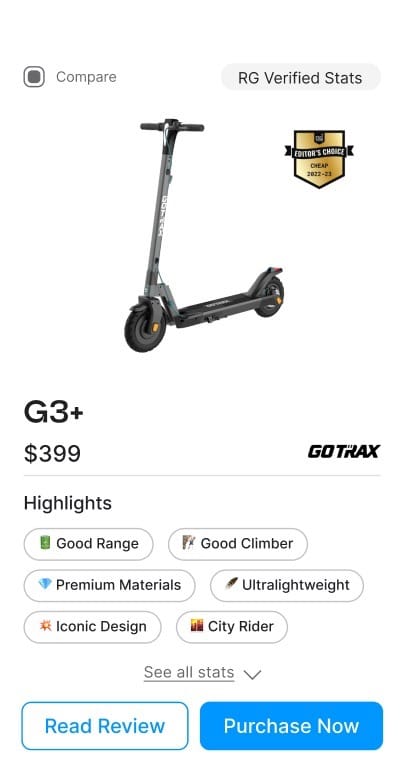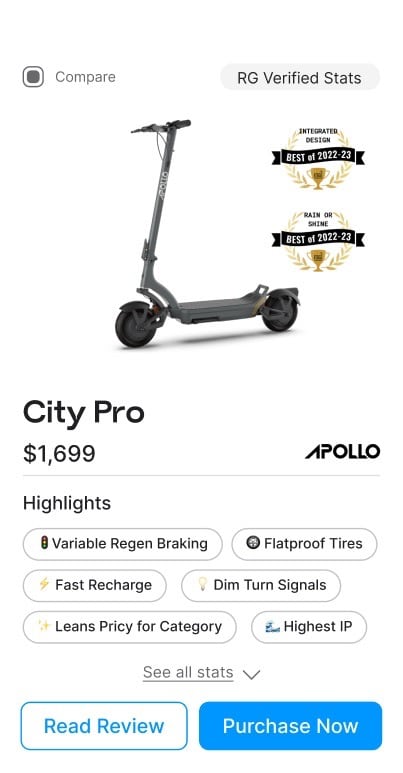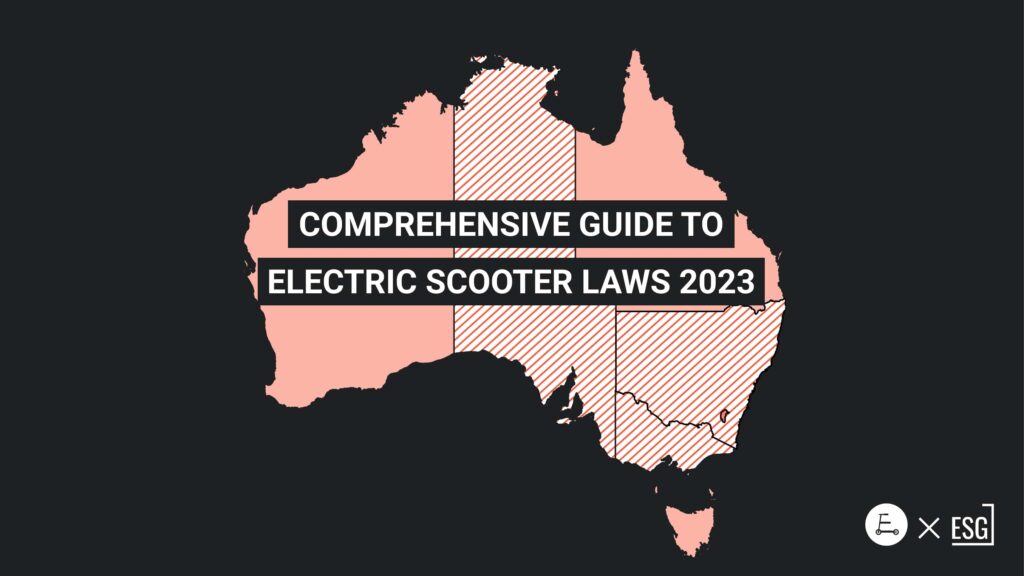
Electric scooter laws in Australia are confusing and constantly changing. That's because we are witnessing a transportation revolution.
Governments have been slow to react to the arrival of each new form of transport. Despite cars having existed for decades, it was 1967 before Australia had speed limits, and only 1971 before cars in Australia had to have seatbelts on every seat. It was only in 1995 that the Civil Aviation Safety Authority was founded to regulate Australia’s aviation industry, and its predecessor, the Civil Aviation Branch of the Department of Defence, was created about 20 years after planes were invented.
So today we sit in a similar position as those who witnessed technology change from one year to the next. But we are watching the future of personal transportation come into being. We are watching the birth of a new era of personal mobility devices.
Governments have been slow to react to the arrival of each new form of transport. Despite cars having existed for decades, it was 1967 before Australia had speed limits, and only 1971 before cars in Australia had to have seatbelts on every seat. It was only in 1995 that the Civil Aviation Safety Authority was founded to regulate Australia’s aviation industry, and its predecessor, the Civil Aviation Branch of the Department of Defence, was created about 20 years after planes were invented.
So today we sit in a similar position as those who witnessed technology change from one year to the next. But we are watching the future of personal transportation come into being. We are watching the birth of a new era of personal mobility devices.
Electric Scooter Laws in Australia
E-Scooters are taking off around the world, and for good reason. With commutes getting longer, housing developments moving further away from anywhere of interest, and emissions from petrol vehicles slowly rewriting our future on this planet, the e-scooter has arrived at a time when we needed a way of getting around that didn’t require excessive exercise or an expensive fuel source, but was still practical & cheap.
Electric scooters will eventually change the way many of us get around town, but our various governments will also play a significant role in how this technology is distributed across our country. Like most legislation, we can expect changes, backflips, and contradictions until we settle on a firm set of rules that control the use of electric scooters. While that evolves behind us, Electric Kicks and RG offer the following look at exactly what the laws are for electric scooters in each of Australia’s states.
Electric scooters will eventually change the way many of us get around town, but our various governments will also play a significant role in how this technology is distributed across our country. Like most legislation, we can expect changes, backflips, and contradictions until we settle on a firm set of rules that control the use of electric scooters. While that evolves behind us, Electric Kicks and RG offer the following look at exactly what the laws are for electric scooters in each of Australia’s states.
Some General Riding Advice
We aren’t lawyers, so we don’t dispense advice that’ll protect you if you get in trouble.
BUT… there are some steps you can take to minimise your chances of an interaction with your local law enforcement.
For starters, keep your helmet on. Brain injuries are no joke, so while wearing a lid might disturb your perm for the day, permanent disabilities aren’t something you can fix with a shower and some hairspray. We cannot stress this point enough, so we’ve written it in big letters below.
BUT… there are some steps you can take to minimise your chances of an interaction with your local law enforcement.
For starters, keep your helmet on. Brain injuries are no joke, so while wearing a lid might disturb your perm for the day, permanent disabilities aren’t something you can fix with a shower and some hairspray. We cannot stress this point enough, so we’ve written it in big letters below.
ALWAYS WEAR A HELMET on an Electric Scooter!
Outside of this, a lot of e-scooter riding comes down to common sense, courtesy, and respect.
Common sense:
Show courtesy to:
Respect:
There’s no version of any of the legislation through which we’re about to go through that suggests e-scooter riders are above the law, and there’s no one working harder to slow progression of e-scooter laws than the riders who totally ignore this.
But alas, we’ve covered the general “don’t be a d*ckhead” advice. Some of these guidelines might be more obvious than others, but we’re always happy to answer questions at Electric Kicks. Now, let’s look at what the state government’s laws are for electric scooters
Common sense:
- Always have lights fitted
- Don’t drink & ride
- Don’t take drugs & ride
- Don’t use your phone while riding
- Don’t do stunts
- Don’t carry passengers
- Don’t ride down the middle of the road among traffic
- Don’t do 60kph through a pedestrian zone
Show courtesy to:
- Pedestrians
- Other e-scooter users
- Law enforcement (manners cost you nothing and go a long way in getting you off with a warning)
- Cyclists
- Any other road user
Respect:
- Local speed limits
- Traffic
- Pedestrians
- Other e-scooter users
- Traffic lights
- Pedestrian crossings
- Cyclists and their silly lycra
There’s no version of any of the legislation through which we’re about to go through that suggests e-scooter riders are above the law, and there’s no one working harder to slow progression of e-scooter laws than the riders who totally ignore this.
But alas, we’ve covered the general “don’t be a d*ckhead” advice. Some of these guidelines might be more obvious than others, but we’re always happy to answer questions at Electric Kicks. Now, let’s look at what the state government’s laws are for electric scooters
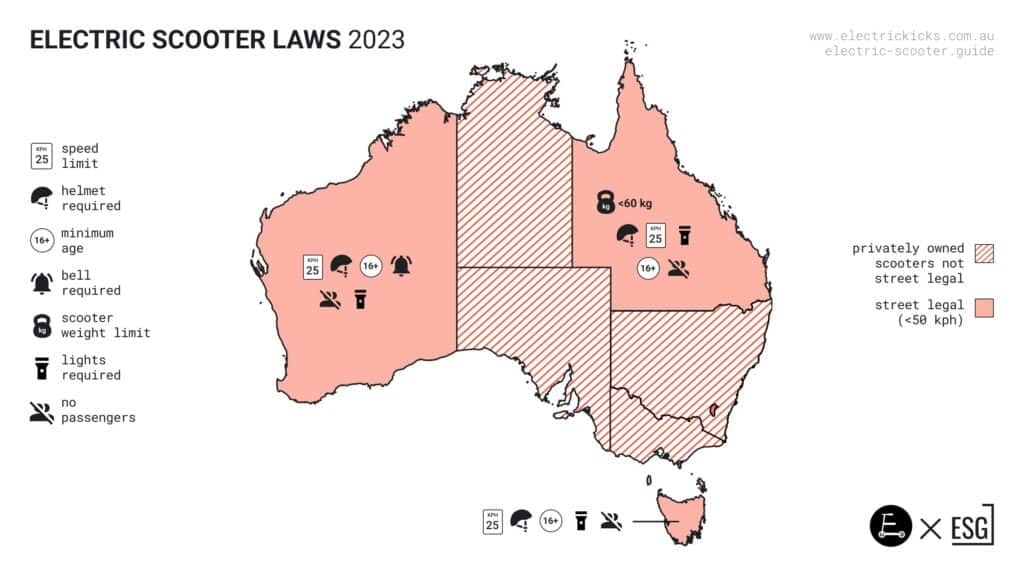
Australian Capital Territory E-Scooter Laws
Good news for Canberrans – private electric scooters are legal in ACT, but only in select areas. Currently private electric scooters can be ridden in central Canberra & Belconnen town centre where electric scooter trials are active.
As you’d expect, there are rules surrounding their use:
As you’d expect, there are rules surrounding their use:
- Always wear a helmet,
- Abide by the speed limit:
- Shared path or bike path: 25kph,
- 15 kph for footpaths,
- 10 kph when using a crossing,
- Don’t ride under the influence of alcohol or drugs,
- One person per scooter – no doubling up and no passengers
- Children under the age of 12 most be supervised by an adult
- Use the path – no riding on roads unless there is no path, or it is not practical/ safe to use the path
ACT Shared E-Scooter Trials
Beam & Neuron Mobility both have shared e-scooter trials active in Canberra, with plans to expand the trial. Expansion would connect Canbera to Belconnen, then expand to include Gungahlin, Woden, Tuggeranong, Weston Creek, and Molongo.
New South Wales E-Scooter Laws
Unfortunately, NSW doesn’t have a particularly liberal approach to electric scooters, with blanket rules prohibiting the use of private electric scooters anywhere in the state except on private property.
While Neuron Mobility electric scooter trials are underway, even that is governed by a strict & extensive set of rules:
While Neuron Mobility electric scooter trials are underway, even that is governed by a strict & extensive set of rules:
- E-Scooters can only be used through an approved shared e-scooter scheme,
- Shared e-scooters can only be used in trial areas of Western Sydney Parklands & Australian Botanic Gardens
- Riders must be over the age of 16 years old
- E-Scooters can only be ridden in bicycle lanes & paths, on shared paths, and roads with a speed limit up to 50kph
- E-scooters can’t be ridden on footpaths
- On shared paths, riders must:
- Stay under 10 kph
- Give way to pedestrians
- Keep to the left
- Riders must go no faster than 20kph on roads, bike lanes, & bike paths
- Riders must use an approved bicycle helmet
- Riders must use lights when riding in darkness or hazardous weather conditions
- Riders must not be over the Blood Alcohol Limit (BAC) of 0.05 when riding
- Riders must now be under the influence of alcohol or drugs
- Riders must not use phones while riding
- Riders must not carry passengers
- Riders must ride in single file
NSW Shared E-Scooter Trials
From July 2022, the Australian Botanic Garden in Mount Annan partnered with Bird for a trial, which is expected to run until July 2023.
Western Sydney Parklands has partnered with Beam, Neuron, & Lime for their trial.
Western Sydney Parklands has partnered with Beam, Neuron, & Lime for their trial.
Northern Territory E-Scooter Laws
Northern Territory’s regulations are similar to New South Wales in that only electric scooters provided by a shared e-scooter trial scheme can be used. In NT, this means that only Neuron Mobility scooters can be ridden.
This also means that privately-owned electric scooters cannot be ridden, and this rule applies across the whole state.
NT has a similarly extensive list of rules regarding the use of e-scooters. Riders must:
This also means that privately-owned electric scooters cannot be ridden, and this rule applies across the whole state.
NT has a similarly extensive list of rules regarding the use of e-scooters. Riders must:
- be at least 18 years old
- Wear an approved, securely-fitted helmet
- Only ride on footpaths, shared paths, & bicycle lanes
- Keep to the left
- Give way to pedestrians
- Not travel on roads for more than 50m unless there is an obstruction on the footpath, nature strip, or shared path, or the preferred path is unsafe/ impractical to ride on
- Observe a speed limit of 15 kph
- Use front & rear lights when riding at night
- Have their ride fitted with a warning device, e.g. bell

Along with Tasmania, Queensland is one of the first states to actually create laws that apply to electric scooters specifically, rather than trying to crowbar 20-year old automobile legislation into filling the job.
Privately-owned electric scooters are legal to use in Queensland, provided riders follow two sets of rules: one that applies to the rider, and a second that applies to the ride itself.
The Rider must:
Where no separate bike lane exists, e-scooters in Queensland shouldn’t be used on roads for more than 50m unless there is an obstruction of some sort on the preferred route, or the preferred route is unsafe/ unsuitable.
Queensland also specifies that riders aren't allowed to be towed by another vehicle, hold onto the back of another vehicle, or ride closer than 2m behind another moving motor vehicle continuously for more than 200m.
Outside of that, riders must not ride anywhere that specifically states personal mobility devices are not allowed.
Privately-owned electric scooters are legal to use in Queensland, provided riders follow two sets of rules: one that applies to the rider, and a second that applies to the ride itself.
The Rider must:
- Be at least 16 years of age, or 12 with adult supervision
- Wear an approved bicycle helmet that is securely fitted unless an exemption has been granted for medical or religious reasons
- Not carry passengers
- Not use a mobile device while riding
- Not drink alcohol & ride
- Be under the influence of alcohol or drugs while riding
- Have a working flashing or steady white light on the front, and a red light and reflector at the rear when travelling at night or in hazardous conditions
- Keep left and give way to pedestrians
- Travel at a speed that allows riders to safely stop to avoid collisions
- Travel at a safe distance from pedestrians
- Keep left of oncoming bicycles and other personal mobility devices
- Only use the bicycle side of a shared path
- Be designed for user by a single person only
- Fit the following dimensions:
- 1,250mm in length, 700m in width, 1,350 in height
- 700mm in length, 1,250mm in width, and 1,350mm in height
- Have a maximum speed of 25kph
- Have a maximum weight of 60 kg when not carrying a person or load
- Be powered by an electric motor
- Have 1 or more wheels
- Have a braking system
- Have no sharp protrusions
Where no separate bike lane exists, e-scooters in Queensland shouldn’t be used on roads for more than 50m unless there is an obstruction of some sort on the preferred route, or the preferred route is unsafe/ unsuitable.
Queensland also specifies that riders aren't allowed to be towed by another vehicle, hold onto the back of another vehicle, or ride closer than 2m behind another moving motor vehicle continuously for more than 200m.
Outside of that, riders must not ride anywhere that specifically states personal mobility devices are not allowed.
QLD Shared E-Scooter Trials
There are multiple electric scooter trials happening all over Queensland with varying details:
- Brisbane is active with Beam & Neuron Mobility
- Bundaberg is currently running a Neuron Mobility trial
- Townsville is also running a Beam & Neuron trial, but with heavy restrictions on where & when e-scooters can be used
- Rockhampton is trialling Neuron scooters
- Ipswich is planning on running an e-scooter trial in Springfield Central
South Australia E-Scooter Laws
In South Australia, only electric scooters involved in shared e-scooter schemes are allowed to be used within certain areas.
South Australia’s laws are more contradictory in nature, stating that electric scooters are considered motorised vehicles that need to be registered and insured. However, as e-scooters don’t meet Australian safety standards (i.e. no compliance plates), they can’t be registered, and as such, they remain illegal to be used on roads. Privately-owned electric scooters can only be used on private property.
Here are the rules that apply for using shared electric scooters. Riders:
South Australia’s laws are more contradictory in nature, stating that electric scooters are considered motorised vehicles that need to be registered and insured. However, as e-scooters don’t meet Australian safety standards (i.e. no compliance plates), they can’t be registered, and as such, they remain illegal to be used on roads. Privately-owned electric scooters can only be used on private property.
Here are the rules that apply for using shared electric scooters. Riders:
- Must be at least 18 years old
- Must wear an approved bike helmet that is securely fitted
- May ride on footpaths and shared paths unless otherwise stated
- May ride on a road for up to 50m when crossing or when avoiding an obstruction
- If on a road, riders must keep as far left as possible and obey traffic signals
- Must have a warning device such as a bell
- Must use a flashing or steady white light at the front and a flashing red light & reflector at the back when riding at night or in hazardous conditions
- Must not exceed 15kph
- Must not not ride side-by-side with other riders
- Must not carry passengers
- Must not be under the influence of alcohol or drugs
- Must not use a mobile device while riding
- Must not carry e-scooters on public transport
SA Shared Electric Scooter Trials
Riders will be able to find Beam & Neuron Mobility electric scooters in:
- Adelaide
- North Adelais
- The City of Norwood, Payneham & St. Peters
- Along the Coastal Park Trail
- The City of Unley
Tasmania E-Scooter Laws

Like Queensland, Tasmania’s laws relating to use of privately-owned electric scooters are much more relaxed than most of Australia. Laws are set at a state level & control riding across every town & city.
Both private & shared electric scooters in Tasmania can be ridden on shared paths, footpaths, & bicycle paths. It is also one of the states that allows riders to use their scooter on roads provided the speed limit is 50kph or less. The only exception to this is when there are lane markings on roads, regardless of the speed limit.
Here are the specific laws relating to riding an e-scooter in Tasmania. Riders:
Both private & shared electric scooters in Tasmania can be ridden on shared paths, footpaths, & bicycle paths. It is also one of the states that allows riders to use their scooter on roads provided the speed limit is 50kph or less. The only exception to this is when there are lane markings on roads, regardless of the speed limit.
Here are the specific laws relating to riding an e-scooter in Tasmania. Riders:
- Must be over the age of 16
- Under the age of 16 can ride low-powered e-scooters that do not exceed 200W and cannot go faster than 10kph
- Must wear an approved helmet
- Must not ride where a ‘No Personal Mobility Device’ sign is displayed
- Must not exceed 15 kph on footpaths
- Must not exceed 25 kph on shared paths, bicycle paths, and roads
- Must not carry passengers
- Must give way to pedestrians
- Keep left unless overtaking
- Must not use a mobile device while riding
- Must not be under the influence of alcohol or drugs
- Must have a front white light, a rear red light, and a red rear reflector
Tasmania Shared Electric Scooter Trials
Hobart & Launceston have launched e-scooter trials with Beam & Neuron.
Victoria E-Scooter Laws
Similar to NSW, Victoria’s laws are quite restrictive when it comes to electric scooters. Privately-owned electric scooters are not allowed to be ridden on public roads or footpaths, so their use must be kept to private property only.
Victoria also places limits on e-scooter power as well, with a limit on motor power of 200W, which is less than your average kettle, and a maximum speed of 10kph. Beyond that, e-scooters are classed as a motor vehicle and need to be registered. Similar to South Australia, however, e-scooters do not meet the criteria for registration and so can’t be used on roads.
If riders are taking part in one of the e-scooter trials occurring across Melbourne, then here are the rules that apply. Riders:
Victoria also places limits on e-scooter power as well, with a limit on motor power of 200W, which is less than your average kettle, and a maximum speed of 10kph. Beyond that, e-scooters are classed as a motor vehicle and need to be registered. Similar to South Australia, however, e-scooters do not meet the criteria for registration and so can’t be used on roads.
If riders are taking part in one of the e-scooter trials occurring across Melbourne, then here are the rules that apply. Riders:
- Must only ride a commercial hire scooter from an approved operator
- Must only ride in participating council areas
- Can only ride on bicycle lanes, shared paths, and lower speed roads (up to 50kph)
- Must not ride on footpaths
- Must not exceed 20 kph
- Must be at least 18 years old
- Must wear a helmet
- Must not ride under the influence of alcohol or drugs
- Must not consume intoxicating substances while driving
- Must not use a mobile device while riding
- Must not carry passengers
- Must ride single file
Victoria Shared E-Scooter Trials
Currently, Lime & Neuron Mobility are running e-scooter trials in Victoria. These can be found in Melbourne (CBD), Yarra, Port Philip, & Ballarat.
Western Australia

With legislation closer to Queensland & Tasmania, Western’s Australia laws permit the use of electric scooters on footpaths, bicycle paths, shared paths, and local roads, provided those roads have no centre lines and a speed limit of 50kph or less.
Electric scooters are classed as ‘eRideables’ as long as they are less than 125cm long. 70cm wide, and 135cm high. They should also weigh less than 25kg and be incapable of going faster than 25kph on level ground.
The current laws are as follows:
Electric scooters are classed as ‘eRideables’ as long as they are less than 125cm long. 70cm wide, and 135cm high. They should also weigh less than 25kg and be incapable of going faster than 25kph on level ground.
The current laws are as follows:
- One person per eRideable
- Approved helmets must be worn at all times
- Riders must be over the age of 16
- All eRideables should have a bell
- Lights & reflectors are required at night
- Riders must obey 10kph speed limit on footpaths, or 25kph on bike paths, shared paths, and local roads
- Riders must not use a mobile phone when riding
- eRiders must not be under the influence of drugs or over the legal drink-driving limit
Western Australia Shared E-Scooter Trials
Only Sterling City to the North-West of the CBD is currently running a shared electric scooter trial with Neuron Mobility.
Some Consistencies

Throughout all of these states, some regulations appear consistently, and whether you choose to follow your local legislation to the letter or not, some rules stay true:
When it comes to e-Scooters, sharing isn’t caring.
- Always wear a helmet
- Don’t Drink & Ride
- Don’t Use Your Phone
- Observe Local Speed Limits
- No Piggy-Backs
When it comes to e-Scooters, sharing isn’t caring.
Respect The Ride
One of the biggest issues with using electric scooters in Australia is the discrepancy between the law and the consequent enforcement of that law. It’s erratic at best, with most riders being left to their own devices.
When reading news stories about riders of e-scooters getting in trouble, there are usually a few consistencies:
If you are unfortunate enough to get stopped, compliance & manners are your best friends.
When reading news stories about riders of e-scooters getting in trouble, there are usually a few consistencies:
- The rider wasn’t wearing a helmet
- The rider was speeding
- The rider was under the influence
- The rider was carrying a passenger
- The rider was using a phone
- The rider was riding through a pedestrian zone
If you are unfortunate enough to get stopped, compliance & manners are your best friends.
Still Some Way to Go…
States such as Queensland, Western Australia, & Tasmania are leading the way with regards to electric scooter legislation. Rather than trying to force legislation designed for cars and motorbikes to apply to e-scooters, they have created a new set of unique rules & guidelines that govern the safe use of electric scooters.
There are increasing calls across the country for legalisation of electric scooters as long as that comes with increased regulation and public awareness programs similar to those in the early 1990s when it became mandatory to wear a helmet while cycling.
With more cars on the road than ever before, fuel prices & general cost of living spiralling upwards, crowded public transport, and more of us working from home, electric scooters solve a number of problems in a variety of different ways.
As with all the other forms of transport listed at the beginning of this article, however, governments are generally slow to react. While the legalisation will likely come in the next 5 years, for the time being, we’ll have to make do.
Or move to Tasmania, where the laws are most relaxed.
There are increasing calls across the country for legalisation of electric scooters as long as that comes with increased regulation and public awareness programs similar to those in the early 1990s when it became mandatory to wear a helmet while cycling.
With more cars on the road than ever before, fuel prices & general cost of living spiralling upwards, crowded public transport, and more of us working from home, electric scooters solve a number of problems in a variety of different ways.
As with all the other forms of transport listed at the beginning of this article, however, governments are generally slow to react. While the legalisation will likely come in the next 5 years, for the time being, we’ll have to make do.
Or move to Tasmania, where the laws are most relaxed.
Related Reviews
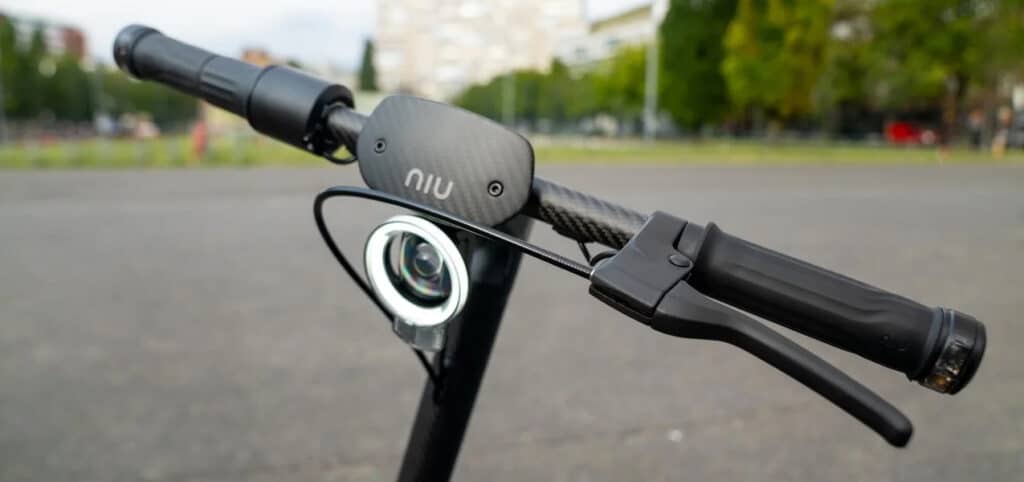

KQi Air
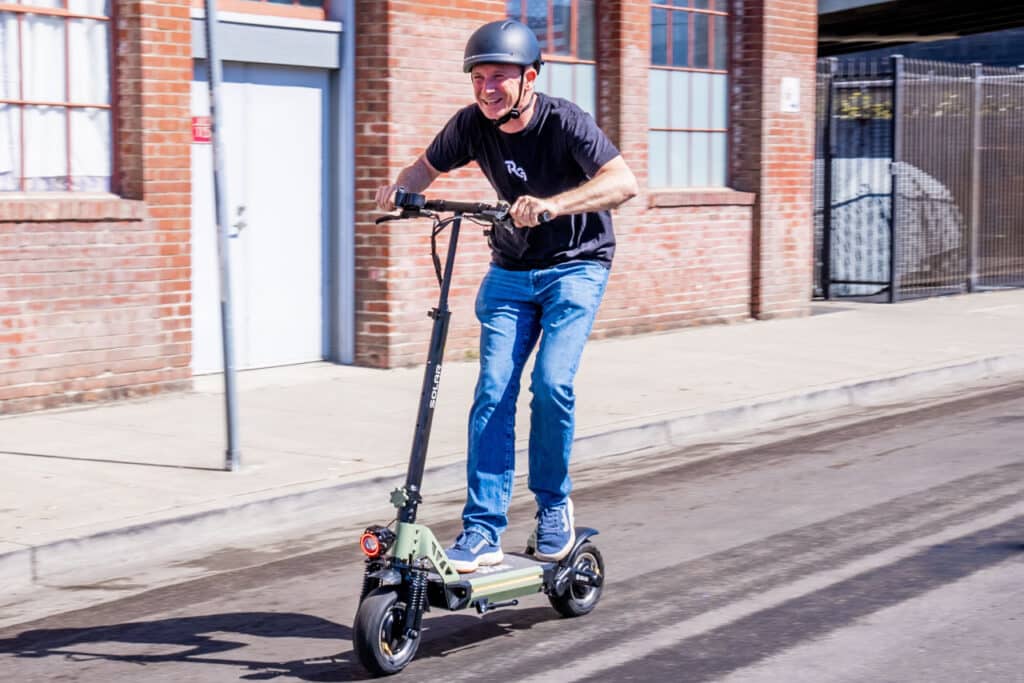

EQ


Ninebot F2 Pro
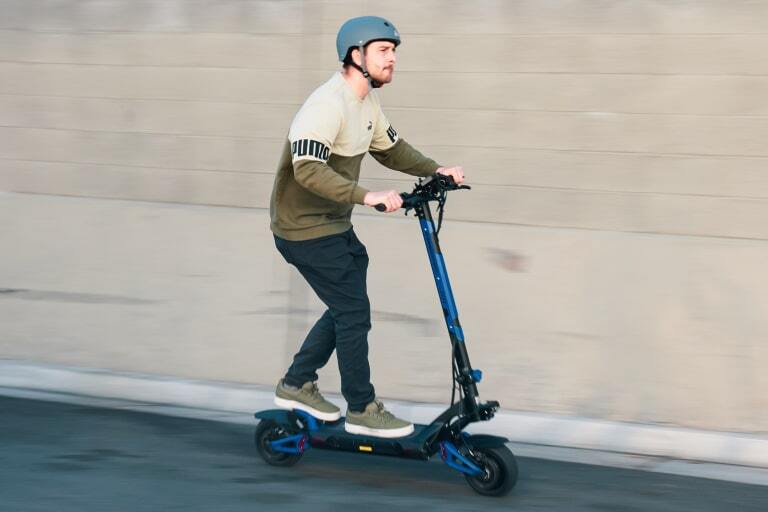

RS5+
Scooter with Swappable Battery!

Our newsletter has the biggest discounts, newest scooter reviews, best how-to’s, & no spam. Unsubscribe anytime!
Find your perfect ride
We built a tool that makes it effortless for you to find a scooter perfect for your lifestyle. Filter, compare, and sort through almost every electric scooter in the industry.
jump injump in



